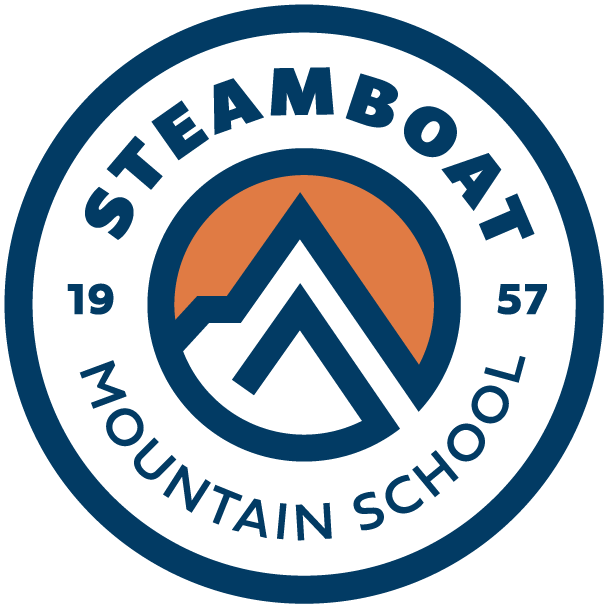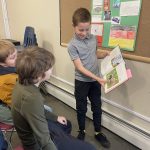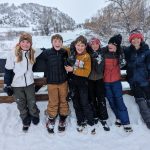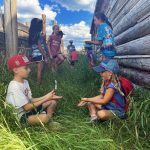May 1, 2023
Salam!
We last left you after an overwhelmingly heartfelt homestay in the Rif Mountains. The sincerity of the time with our families continues to impact our time in Morocco. We talk about Mustafa’s epic goalie performance during the village soccer game, Jason’s dad persona as his home-sisters fell asleep on his chest, and Isabella’s connection with the three kittens born 2 days before our arrival. It was sad to say goodbye, but we had a new destination in mind: the Sahara Desert.
Over the following week, we logged a lot of time on the bus. A lot. The Sahara Desert is a distant destination and a drastic geographic change from our time in the rainforests last year. We split up the drive into a few stops and we started in Fez. Fez is the cultural capital of Morocco. The city was founded in 700 CE and has one of the oldest medinas in Africa. The history is palpable. The medina has 9,600 streets with most buildings looking the exact same, but once you open the doors the intricate tiling and colors transport you into a different world. Sam’s photography captured the old buildings in a picturesque light. Our guide took us to the outside of the King’s palace, the Jewish quarter, and one of the first universities in the world. Fez is also known for its leather tannery – a smelly puzzle of pigeon poop and pools of dyes. Yes, soaking leather in pigeon poop is the first step in processing the leather. We found ourselves in leather shops trying on movie star tight, red jackets, shoes, and bags. Bodhi found an especially sleek tan leather trench coat. Our time in Fez was short, but sweet.
Our second destination was Midelt, the apple capital of Morocco. This land between the Atlas Mountains and the desert is perfect for growing red and green apples. Unfortunately, it’s not the season for picking, but we enjoyed an impromptu drum dance party after dinner. Midelt was a logistical stop to break up our journey to the Sahara.
The following day was the one we’d been waiting for. After a few hours in the car we arrived in Merzouga, the gateway to the Sahara Desert. We packed a few items in an overnight bag and mounted our camels to trek into the desolate wilderness to our Bedouin camp. The camels had personality! Everyone was eager to name their companions; some highlights include: Camela Anderson, Camela Harris, Crusty, etc. As we approached our camp, a sandstorm rumbled in the distance and we quickly realized the unforgiving nature of this landscape. At camp, Wyatt grabbed a sandboard and attempted to ride down the dunes. Andrik and Nate started a drum circle and the entire camp enjoyed their musical talent. During the evening we enjoyed the stars and a fire. We enjoyed chatting with the other travelers in the camp, reflecting on our time in this beautiful country. The next morning we remounted our trusty camels. We trekked out before sunrise so that we could enjoy the cresting sun halfway on our ride. This is truly a moment we will never forget.
After a much needed shower, we got back on our trusty bus and winded our way into the Atlas Mountains to the Rose Valley. The Rose Valley is an oasis of beautiful smelling flowers, walnut trees, peach trees, etc. It’s a farmer’s paradise. The roses were in full bloom and during a walk, Ben was ‘hired’ by a farmer to pick some roses. A kilogram of roses earns you 20 dh (about $2). We toured a rose processing factory and visited a local organization that supports women in selling couscous and rose products. Sienna helped roll the couscous dough, which is a laborious process. During the afternoon, we stopped at a dagger shop and learned about this ancient practice for the Amazir population. It’s a trade that’s handed down through families and includes intricate, hand made ornamentation. Finally, we spent an hour at the Rose Festival. This event has been cancelled for the last 5 years and southern Morocco was elated to have it back on the calendar. It’s a four day festival and just happened to overlap with our time in the town. This included numerous stalls selling organic Moroccan food products, festival rides (bumper cars, swings) and all the fried fair food. Cheyenne was first in line for the ferris wheel.
Our destination for the next two nights was Marrakech. This is the hot destination for many Europeans and Moroccans alike for a weekend getaway. The square is full of snake charmers, street performers and people calling you over to their juice stand. We explored the massive medina and went to the Yves Saint Laurent gardens and museum. YSL loved Marrakech and it was a major inspiration for his fashion designs. He owned a home and a large garden, which is now the location for the museum. Grace especially loved the colorful dresses and the short video on YSL’s life. This was a nice juxtaposition to the associations and rural areas we visited previously.
Our last stop in Morocco is the Atlas Mountains. We cannot wait to be at the base of Toubkal (the highest peak in north Africa) and hike around in the mountain air. We are sad that our time in Morocco is coming to an end, but are grateful for all the people that helped make this trip come to fruition.
-Joanie and Cody
April 24, 2023
The last day in Rabat was an idyllic dream. During the morning, we participated in a cooking class with our cohort, Moroccan peers and other African migrants. To set the scene, we discussed privately about migration and immigration in this area of the world. Many people from poor countries come to Morocco for a better economic future, and some hope to illegally cross into Spain on the 9 mile straight. Despite this short distance, it’s a very trechorous crossing, which leaves many left in Morocco to make a better future. We compared this situation to the Mexican border and those crossing into the USA for asylum or economic hope. In our class we had 5 Congolese folks who wanted to learn how to cook a west African-Moroccan fusion dish. Through the myriad of languages we worked together to cook up a variety of foods. From here, we went to the beach for a surfing lesson. The beach is in downtown Rabat and the waves were perfect for beginners. We all caught a wave and will forever have the image of riding white water towards the shore with mosques and minerets in the background. A final meal, a tearful goodbye and one last medina exploration tied a bow on our time with our city families.
Next stop: Chefchaoen, the blue city. This destination was top on the list for many students when we found out we were traveling to Morocco. It’s an old Jewish city from the 15th century Andalusian period when Spain expelled non Christians from their land. The Jewish population came to Morocco and created this city, hidden from outsiders. The blue represents Judaism and peace. We walked around the city with our local guide as he explained the history and brought us to the picturesque corners. The height of our day was visiting the magical Moroccan soap man: a store adorned with soaps, serums, creams, oils, etc. It was an intense olfactory experience.
Week two of our Moroccan adventure saw the group travel from The Blue City to the Rif Mountains where we met our second homestay families. Rouida, the village of the wheel, is a community of farmers, mainly olives and wheat.
Most of the homes in Rouida are constructed of mud brick and plaster, using the same materials and techniques that have been tested and perfected over millennia. The families that hosted us were truly people of the land. Their homes are situated among the fruit trees, gardens, pens and pastures where they grow the things that comprise the majority of what they eat.
Our families were more than happy to share these things with us each night as we sat with them to break the day’s fast during the final week of Ramadan. We also had the privilege of spending Eid, the celebration that marks the end of Ramadan, with our host families. Our last day was spent visiting neighbors, playing games with the local children, drinking tea and eating cookies. When it came time to say goodbye, there were more tears and earnest promises to come back and visit than I’ve ever seen during a homestay farewell.
From Rouida we continue southeast to the ancient city of Fes and then on to the Sahara. We are so excited to explore a new part of this amazing country!
-Joanie and Cody
April 17, 2023
Our adventure began in Malaga, an incredibly beautiful city on the Mediterranean. Surrounded by castle walls and cathedrals, walking down narrow streets paved with marble, our group could feel how rich and ancient Andalusian culture is. After three days exploring the medinas of Malaga and then Tariffa — a period of exploration that was capped off by a meal that many described as “the best they’d ever had” — we boarded the ferry to cross the straight of Gibraltar.
When we disembarked in Tangier, Europe was still visible only nine miles away. However, the African continent and Morocco is a different world. We entered the city, which once marked the most remote edge of the know world, through its central food market. Tangier’s market was an assault on the senses. The vibrant colors of exotic fruits and vegetables, the smell of mounded spices, the chill of the fish market, and the cacophony of bartering in a dozen languages is enough to overwhelm even seasoned travelers.
For our first night in Morocco we went directly to our homestay. There was no time to acclimate or get used to the call to prayer; we arrived late and immediately dispersed to our homes before the sun set. At 7:03 pm the sun dipped below the horizon, the call to prayer echoed through the city and our families broke fast. The tables were covered with food – bread piled between plates of beets, sardines, pastries, dates, turkey bologna, olives and other unidentifiable foods circled around a large tagine. It was ‘bnin’ – ‘delicious’. Our families silently ate at first after a long day of no food or water. Once their stomachs filled, the room overflowed with universal laughter, Arabic and French. You cannot stop eating for more than 10 seconds without someone demanding ‘koolee!!’ – ‘eat!!’ Then they piled more food on the table in front of you. We ate… a lot. After dinner the city came alive – the darkness brings life during Ramadan. Our respective homestay families took us around the medina and the river outside the walls. Many of them were surprised when we asked to go to bed at 11pm.
The following morning we slept in; Ramadan causes everything to open up later. We had a full day ahead of us and ate breakfast with our peers as our families embraced the fast. There is no negative energy towards us when we eat – we’re not Muslim so are not expected to hold similar practices. When we do eat or drink, we do so in the privacy of a home or the bus out of respect to those abstaining. Our day kicked off with a visit to the King’s family grave. Morocco is a constitutional monarchy and Mohammed VI is a highly respected figure. It is also illegal to talk poorly of him and punishable by imprisonment. We’re excited to explore this topic more with our guides throughout our time in Morocco. Our second stop was an association for underprivileged youth in Rabat. We met with a fellow Moroccan peer, Omar, where we received a 1 hour crash course in Moroccan Arabic. This language is a combination of standard Arabic, French, Spanish and the indigenous language. It’s a perfect amalgamation of the country’s history. We learned helpful phrases, words and overall pronunciation. My most used Arabic: ‘bghit qahwa’ – ‘I want coffee’. Afterward, we sat in a circle and a handful of Moroccan students ages 18-25 joined us for a conversation. We talked about everything from popular music to abortion to Islamic law. Turns out, they love rap, especially Kanye and JCole. Abortion was a trickier subject. The Moroccan students expressed their opinions. This conversation showed us that despite being worlds apart, America and Morocco are having paralleled conversations on the same topic. Later that day we separated between males and females to go to a traditional Hammam – public baths. About once a week everyone goes to a hammam to really scrub and bathe themselves. Cleanliness is important in Islamic culture, as you must be clean to pray. We brought buckets from our homestays and enjoyed a truly traditional and authentic Moroccan experience. We are excited to learn more as we stay with our families and soon go to a new homestay in a rural part of the country. We all are embracing the unique opportunity of celebrating Ramadan in an Islamic home.
-Joanie and Cody



